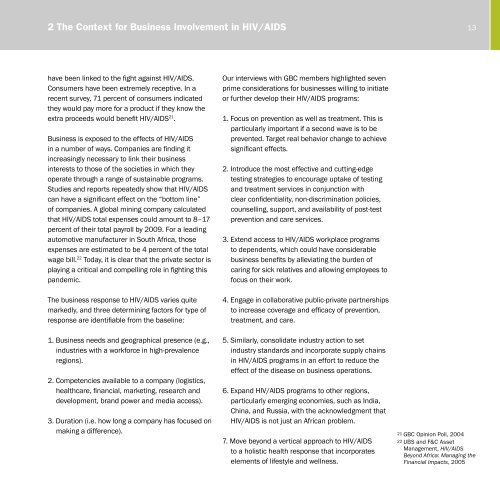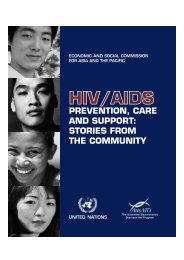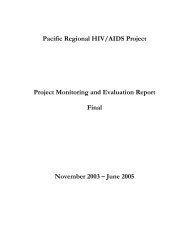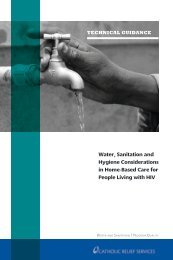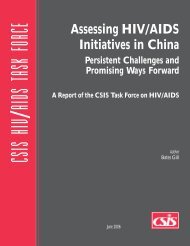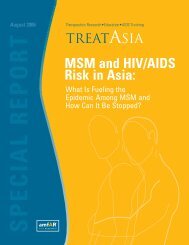The State of Business and HIV/AIDS (2006) - Booz Allen Hamilton
The State of Business and HIV/AIDS (2006) - Booz Allen Hamilton
The State of Business and HIV/AIDS (2006) - Booz Allen Hamilton
You also want an ePaper? Increase the reach of your titles
YUMPU automatically turns print PDFs into web optimized ePapers that Google loves.
2 <strong>The</strong> Context for <strong>Business</strong> Involvement in <strong>HIV</strong>/<strong>AIDS</strong><br />
13<br />
have been linked to the fight against <strong>HIV</strong>/<strong>AIDS</strong>.<br />
Consumers have been extremely receptive. In a<br />
recent survey, 71 percent <strong>of</strong> consumers indicated<br />
they would pay more for a product if they know the<br />
extra proceeds would benefit <strong>HIV</strong>/<strong>AIDS</strong> 21 .<br />
<strong>Business</strong> is exposed to the effects <strong>of</strong> <strong>HIV</strong>/<strong>AIDS</strong><br />
in a number <strong>of</strong> ways. Companies are finding it<br />
increasingly necessary to link their business<br />
interests to those <strong>of</strong> the societies in which they<br />
operate through a range <strong>of</strong> sustainable programs.<br />
Studies <strong>and</strong> reports repeatedly show that <strong>HIV</strong>/<strong>AIDS</strong><br />
can have a significant effect on the “bottom line”<br />
<strong>of</strong> companies. A global mining company calculated<br />
that <strong>HIV</strong>/<strong>AIDS</strong> total expenses could amount to 8–17<br />
percent <strong>of</strong> their total payroll by 2009. For a leading<br />
automotive manufacturer in South Africa, those<br />
expenses are estimated to be 4 percent <strong>of</strong> the total<br />
wage bill. 22 Today, it is clear that the private sector is<br />
playing a critical <strong>and</strong> compelling role in fighting this<br />
p<strong>and</strong>emic.<br />
<strong>The</strong> business response to <strong>HIV</strong>/<strong>AIDS</strong> varies quite<br />
markedly, <strong>and</strong> three determining factors for type <strong>of</strong><br />
response are identifiable from the baseline:<br />
1. <strong>Business</strong> needs <strong>and</strong> geographical presence (e.g.,<br />
industries with a workforce in high-prevalence<br />
regions).<br />
2. Competencies available to a company (logistics,<br />
healthcare, financial, marketing, research <strong>and</strong><br />
development, br<strong>and</strong> power <strong>and</strong> media access).<br />
3. Duration (i.e. how long a company has focused on<br />
making a difference).<br />
Our interviews with GBC members highlighted seven<br />
prime considerations for businesses willing to initiate<br />
or further develop their <strong>HIV</strong>/<strong>AIDS</strong> programs:<br />
1. Focus on prevention as well as treatment. This is<br />
particularly important if a second wave is to be<br />
prevented. Target real behavior change to achieve<br />
significant effects.<br />
2. Introduce the most effective <strong>and</strong> cutting-edge<br />
testing strategies to encourage uptake <strong>of</strong> testing<br />
<strong>and</strong> treatment services in conjunction with<br />
clear confidentiality, non-discrimination policies,<br />
counselling, support, <strong>and</strong> availability <strong>of</strong> post-test<br />
prevention <strong>and</strong> care services.<br />
3. Extend access to <strong>HIV</strong>/<strong>AIDS</strong> workplace programs<br />
to dependents, which could have considerable<br />
business benefits by alleviating the burden <strong>of</strong><br />
caring for sick relatives <strong>and</strong> allowing employees to<br />
focus on their work.<br />
4. Engage in collaborative public-private partnerships<br />
to increase coverage <strong>and</strong> efficacy <strong>of</strong> prevention,<br />
treatment, <strong>and</strong> care.<br />
5. Similarly, consolidate industry action to set<br />
industry st<strong>and</strong>ards <strong>and</strong> incorporate supply chains<br />
in <strong>HIV</strong>/<strong>AIDS</strong> programs in an effort to reduce the<br />
effect <strong>of</strong> the disease on business operations.<br />
6. Exp<strong>and</strong> <strong>HIV</strong>/<strong>AIDS</strong> programs to other regions,<br />
particularly emerging economies, such as India,<br />
China, <strong>and</strong> Russia, with the acknowledgment that<br />
<strong>HIV</strong>/<strong>AIDS</strong> is not just an African problem.<br />
7. Move beyond a vertical approach to <strong>HIV</strong>/<strong>AIDS</strong><br />
to a holistic health response that incorporates<br />
elements <strong>of</strong> lifestyle <strong>and</strong> wellness.<br />
21 GBC Opinion Poll, 2004<br />
22 UBS <strong>and</strong> F&C Asset<br />
Management, <strong>HIV</strong>/<strong>AIDS</strong><br />
Beyond Africa: Managing the<br />
Financial Impacts, 2005


